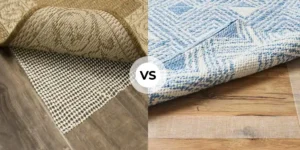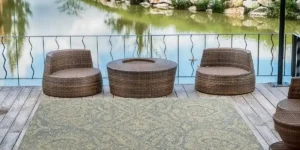Who does not love making their home beautiful and well-furnished? We all want to do that.
But, when it comes to making your home a comfortable, stylish haven, area rugs play a major role. They can also be used to add color, texture, and warmth to any room.
Now let’s talk about carpet padding. Carpet padding provides cushioning and protects your floors from scratches and dents. Additionally, it keeps dirt and dust from becoming trapped between the rugs and the floor.
But, have you ever thought about taking your rug performance to the next level? In that case, a question comes up: Can you use carpet padding under an area rug?
The short answer is yes. You can use carpet padding under the area rugs. It extends the life of the rugs and prevents slipping.
If you want to know more about this, keep reading the article below, so you will find all the information you need to make the best decision.
What is Carpet Padding?
The padding beneath the carpet is called the underlayment or cushion. Also, it is a material placed under wall-to-wall carpeting or area rugs.
It provides durability, comfort, and support. Additionally, it reduces carpet wear, absorbs sound, and improves insulation. It is possible to find carpet padding in different thicknesses, densities, and textures.
There are many types of padding available on the market. But generally, foam padding, rubber padding, and felt padding are the most common types.
#1 Foam Padding
Foam padding is lightweight and breathable, and can adapt to the body’s shape for maximum comfort. While it is more durable than other types of padding, it is also more likely to require frequent replacement.
#2 Rubber Padding
Now, let’s talk about this rubber padding, it’s like the superhero of floor protectors. Seriously, it’s durable and moisture-resistant, making it a great choice for high-traffic areas.
Additionally, it reduces noise and provides good insulation. It is also eco-friendly since it is made of natural rubber and is chemical-free.
#3 Felt Padding
Felt padding provides adequate cushioning and is often made from recycled materials. Moreover, it is eco-friendly and provides insulation, noise reduction, and a soft feel underfoot when used under area rugs.
What are Area Rugs?
The purpose of area rugs is to enhance a room’s appearance and feel. They can be placed over existing flooring to define and accent specific areas, such as hardwood, tile, or carpet.
Also, it comes in a variety of colors, sizes, and materials, so you can create a cozy home. Additionally, they enhance the appearance of a room and protect floors.
Can I use Carpet Padding Under Area Rug?
Yes, you can use carpet padding under area rugs. It’s a smart choice because it adds cushioning, making your rug more comfortable to walk on.
Furthermore, the padding prevents the rug from slipping and sliding. Plus, it protects your rug from wear and tear as it absorbs foot traffic. Also, it helps to prevent the fibers of your rug from flattening.
Also See: Carpet Pads vs Carpet Padding: Which One Should You Get?
Pros and Cons of Using Carpet Padding Under an Area Rug
Pros
- Adding carpet padding softens the rug and makes it more comfortable to walk on.
- Area rugs are protected from wear and tear with carpet padding.
- It prevents slipping and protects the rug from soil and spills.
- It absorbs impact and footstep noises.
- Padding provides extra insulation, keeping rooms warmer.
Cons
- Carpet padding is difficult to install and can be expensive.
- It’s also difficult to keep clean because it’s easily stained.
- It is normal for padding to accumulate dirt over time.
Step-by-Step Guide to Installing an Area Rug with Carpet Padding
Step 1: Gather Your Materials
- Area rug
- Carpet padding
- Double-sided carpet tape or rug gripper
- Knife and scissors
Step 2: Measure and Cut the Padding
First, unroll the carpet padding and measure it. Then fit the same size of rug and cut the padding with scissors to the size of the rug.
Make sure the padding is properly placed on the rug and that all the edges are smoothed out. Using the tape provided, fix the padding to the floor.
Step 3: Prepare the Floor
Remove dirt, dust, and debris from the floor before installing an area rug with carpet padding by vacuuming or sweeping.
Check for uneven spots and bumps, and level them. It is important to ensure the surface is clean and dry. A stable floor allows the rug and padding to lay flat and securely.
Step 4: Lay the Carpet Padding
Once your floor is completely cleaned, then you can lay your carpet padding under the area rug.
Ideally, the cut padding should be spread on the floor so that it covers the entire underside of the area rug. It is important to smooth out any wrinkles or folds in the padding so that it lies flat.
Step 5: Position the Rug
Place the area rug carefully on top of the carpet padding. You should make sure that it is centered and aligned properly with the layout of the room.
As well as improving aesthetics and safety, a properly positioned rug reduces tripping and slipping risks.
Step 6: Secure the Rug
You can secure the rug’s corners and edges with double-sided carpet tape or rug grippers. To prevent movement, apply the tape or gripper evenly beneath the rug’s edges.
Additionally, you can use a rug pad beneath the rug to increase its stability and cushioning. It will prevent the rug from slipping or wrinkling and keep it in place.
Step 7: Trim Excess Padding and Adjust
If extra padding is visible outside the rug’s edge, trim it with scissors to avoid being seen. It is important to adjust the rug gently to ensure it is flat and any wrinkles are smoothed out. Finally, vacuum the rug to remove any dust and dirt.
Maintenance and Caring for an Area Rug with Padding
- Regular Vacuuming: It is important to clean your rug pad at least once a week to remove dirt, dust, and debris with the help of a vacuum cleaner. By doing this, particles will not settle deep into the rug’s fibers and padding.
- Spot Cleaning: Spot cleaning is also an important part of maintaining the area rug. If a spot appears on your rug, clean it immediately with a damp cloth or carpet cleaner. Avoid spreading stains by blotting, not rubbing.
- Rotate the Rug: Rotate the rug every 6-12 months for even wear and lessen the effects of foot traffic. Additionally, rotating the rug can improve the air quality of the room.
- Professional Cleaning: A professional rug cleaning may be necessary every 1-2 years if the rug gets heavily soiled. In addition, professional cleaning services can eliminate allergens that cause discomfort.
- Inspect Padding: Regularly inspect the padding beneath the rug. To maintain comfort and protection, replace damaged or compressed components.
Check Out More Related Floorings:
- Cork vs. Rubber Underlayment: Which One Should I Choose?
- How to Move Your Fridge without Scratching the Floor? (Tried & Tested)
- 7 Best Canister Vacuum for Hardwood Floors (Must-See!)





